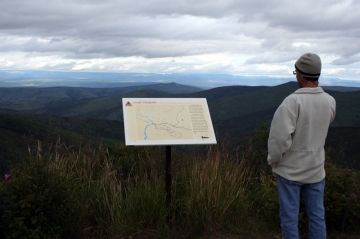Ridge Road Heritage Trail

Trail Length: 33 kilometre
Difficulty: Moderate
Park Amenities:
Ridge Road Heritage Trail
The Ridge Road Heritage Trail is a recreation route located in Dawson City, Yukon Territory, Canada. The trail was built during the Klondike Gold Rush and it was the first wagon road built by the Yukon Government.
 In 1899, during the Klondike Gold Rush, the Ridge Road Trail was constructed to service the big mines located on Sulphur Creek and Dominion Creek. The road followed the banks of Bonanza Creek and Hunker Creek. Bonanza Creek is the birthplace of the Klondike Gold Rush.
In 1899, during the Klondike Gold Rush, the Ridge Road Trail was constructed to service the big mines located on Sulphur Creek and Dominion Creek. The road followed the banks of Bonanza Creek and Hunker Creek. Bonanza Creek is the birthplace of the Klondike Gold Rush.
During the Klondike Gold Rush there were many roadhouses and transportation suppliers who set up shop on the trail. For a few years they serviced the supply wagons, miners and carriages. However, the prosperity was short lived as the route only stayed in operation until 1902. It was then that new and better roads were built.
In 1994 a community group lobbied for the historic road to become a protected historic site. It worked. In 1996 the road was designated a Yukon Territory Heritage Trail. Today, some of the activities enjoyed on the trail include hiking, backpacking, mountain biking and horseback riding. And during the winter months the route is used as a snowmobile, dog sledding, cross country ski route and as a trapper line.
The Ridge Road Trail is a 33 kilometre route exploring the mining history of the Yukon. It is an opportunity to follow in the same footsteps as the early miners. The route is a long day ride (mountain bike or horseback) or a 2-3 day backpacking adventure with wilderness camping.
The route is a one way route with two trailheads. There are four main points located along the route - the Yukon Ditch, 11 Mile Camp, 15 Mile Camp and the Soda Station. The main entrance is the Jackson Gulch Trailhead located on Molison Drive in the Callison Industrial Subdivision (east of Dawson City).
From the Jackson Gulch Trailhead the route travels 3.7 kilometres to the Yukon Ditch. The Yukon Ditch was the site of a diversion system designed to bring water down from the local mountains for operating the mines. Also you may come across some mining artifacts and a watchman's cabin. Do not touch just look.
From the ditch continue along the Ridge Road Heritage Trail for another 7.7 kilometres to the 11 Mile Campground. 11 Mile was once the site of a two roadhouses (one on each side of the road), a bar and a restaurant during the Klondike Gold Rush. Now it is a wilderness campsite.
Continue along the heritage trail from 11 Mile for another 8.4 kilometres to the next campground at 15 Mile. During the golden days this was the site of another roadhouse and a halfway house. Now it too is a wilderness campsite.
The last leg of the trail is the 10.3 kilometre trek from 15 Mile to the Soda Station. The Soda Station was a converted box car used for storing goods for the railway companies servicing the mines. The box car is still standing.
There are pit toilets located at the Upper Trailhead and at the two campgrounds. The amenities provided at the campgrounds include picnic tables, fire pits, well water and tent pads. No power. No garbage pick up. Only responsible camping permitted.
You can make a short day hike when starting from each trailhead. From the northwest trailhead (Jackson Gulch) to the Yukon Ditch (3.7 kilometres one way) and from the southeast trailhead (Upper Trailhead) on Bonanza Creek Road to the Soda Station (2.4 kilometres one way).
When exploring the trail please, please be advised that there is no garbage collection along the route which means pack out what you pack in.
Explore the Ridge Road Heritage Trail in Dawson City, Yukon Territories, Klondike Region, Canada
Address:
How To Get ToRidge Road Heritage Trail
:To access the Upper Trailhead continue further on the Klondike Highway and turn onto Bonanza Creek Road. Follow Bonanza Creek to Upper Bonanza Creek Road. Turn left onto Upper Bonanza Creek and follow it to the trailhead which is right before the King Dome.





